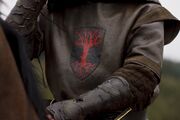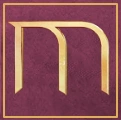- “It's carved from the Rowan Tree that grows at the very heart of the Isle of the Blessed.”
- — Morgause on the Tree
The Rowan Tree is a tree found on the Isle of the Blessed. This tree has been very important to the High Priestesses, their Blood Guard and all the other followers of the Old Religion.
History[]
It is assumed that the Rowan Tree was in existence when Merlin met Nimueh on the Isle of the Blessed because, according to Morgause, it lies at the "heart" of the Isle of Blessed (Le Morte d'Arthur).
During the Great Battle for Camelot, Morgause gave Morgana a staff carved from the wood of the Rowan Tree to allow her half-sister to resurrect several skeletons using necromancy. Later Merlin destroyed the staff causing the skeletons to collapse (The Tears of Uther Pendragon).
The Rowan Tree appeared on Queen Morgana's crest when Morgause conquered Camelot with her immortal army (The Coming of Arthur). It's also the symbol on the Blood Guards' uniform (The Tears of Uther Pendragon
).
The Rowan Tree on one of the Blood Guards' uniform.
It is assumed that the Rowan Tree appeared around the time when the Dorocha were released (The Darkest Hour).
Trivia[]
- In the audio-commentary of The Coming of Arthur: Part Two, it was revealed that Morgana and Morgause's crest when they conquered Camelot, the red tree on a black banner, represents the Rowan Tree. It is also the symbol of the Blood Guard.

The Fomorroh medallion
- It was also the clue that led the player to find out Morgana's true whereabouts between Series 2 and Series 3 on the interactive game The Quest for Morgana, featuring Katie McGrath.
- The Fomorroh medallion resembles the sacred Rowan Tree, perhaps alluding to a connection between the two.
Mythology[]
- "Greek mythology tells of how Hebe the goddess of youth, dispensed rejuvenating ambrosia to the gods from her magical chalice. When, through carelessness, she lost this cup to demons, the gods sent an eagle to recover the cup. The feathers and drops of blood which the eagle shed in the ensuing fight with the demons fell to earth, where each of them turned into a rowan tree. Hence the rowan derived the shape of its leaves from the eagle's feathers and the appearance of its berries from the droplets of blood." [1]
- "In Norse mythology as the tree from which the first woman was made, (the first man being made from the ash tree). It was said to have saved the life of the god Thor by bending over a fast flowing river in the Underworld in which Thor was being swept away, and helping him back to the shore."[1]
- "In Celtic legend, it is always connected with either Druids or other practitioners of magic." [2]
- "Rowan is also used during rites of the 2nd moon - the moon of vision for rites of knowledge and divination. If the branches are gathered at Beltane (May Day) they can be tied with red yarn hung above openings to protect your house. The Scots would plant rowan near their houses to protect from lightning and evil. The berries and leaves are dried and burned to invoke/banish spirits, fairies, elements, and the Earth Mother. Rowan wood was burned by druids of opposing armies to summon spirits-to take part of battle. The Silver Branch that is often carried in Druid rites and ceremonies, is usually made of Rowan, to celebrate and honour the Goddess." [2]
- "The sorb apple, fruit of the rowan, symbolises corruption and sweetness. It is not edible until it rots to a purplish colour. ... The berries have a tiny pentagram on them. The pentagram is the ancient symbol of protection. The pentagram shape is one of the reason's why it has been called the Witch Tree. The Rowan tree indicates protection and control of the senses from enchantment and possesses the power of the psychic, healing, power, success, and protection. If carried, Rowan wood will increase one's psychic powers. Branches of Mountain Ash often were used in dowsing rods and magical wands. Leaves and berries are added to divination incense for better scrying. Rowan berries and bark are added to healing and health baths, sachets, and also in power, success, and luck sachets. Carrying the berries/bark aids in recuperation. If two twigs are tied together with red thread as a cross, one would possess a protection amulet." [2]
- "The symbolism and Celtic meaning of the rowan tree deals with: Power, Vision, Balance, Healing, Mystery, Connection, Protection, Divination, [and] Transformation" [3]
- "More evidence of this protective energy in the white flowers of the rowan. Beautiful, bold, and crisp, these white flowers are symbolic of cleansing and safekeeping."[3]
- "Rowan is also used during rites of the 2nd moon - the moon of vision for rites of knowledge and divination. If the branches are gathered at Beltane (May Day) they can be tied with red yarn hung above openings to protect your house. The Scots would plant rowan near their houses to protect from lightning and evil. The berries and leaves are dried and burned to invoke/banish spirits, fairies, elements, and the Earth Mother. Rowan wood was burned by druids of opposing armies to summon spirits-to take part of battle. The Silver Branch that is often carried in Druid rites and ceremonies, is usually made of Rowan, to celebrate and honor the Goddess." [2]
Other Interesting Facts[]
- "The rowan's wood is strong and resillient, making excellent walking sticks, and is suitable for carving. It was often used for tool handles, and spindles and spinning wheels were traditionally made of rowan wood. Druids used the bark and berries to dye the garments worn during lunar ceremonies black, and the bark was also used in the tanning process. Rowan twigs were used for divining, particularly for metals. The berries can be made into or added to a variety of alcoholic drinks, and different Celtic peoples each seem to have had their favourites. As well as the popular wine still made in the Highlands, the Scots made a strong spirit from the berries, the Welsh brewed an ale, the Irish used them to flavour Mead, and even a cider can be made from them. Today rowan berry jelly is still made in Scotland and is traditionally eaten with game." [1]
- "It is associated with the colours of red and grey." [2]
- "Rowan bark will dye fabric grey." [2]
- "[The berries] can substitute coffee beans, can flavour liqueurs/cordials, and can be used to make ale."[2]
- "It is also known as the Tree of Quickening, Round wood, Delight of the Eye, Mountain Ash, Quickbane, Roden-Quicken, Roden-Quicken-Royan, Royne Tree, Sorb apple, Service Tree, Thor's Helper, Whitty, Wicken-Tree, Wiggin, Wiggy, Wiky, Wild Ash, Witchbane, Witchen, Witch Wood and Tree of Life." [2]
- "Celtic Tree Astrology recognizes Rowan signs as the philosophical minds within the zodiac. If you were born under the Rowan energy (January 21 – February 17), you are likely a keen-minded visionary, with high ideals. Your thoughts are original and creative, so much so, that other’s often misunderstand from where you are coming. This sometimes makes you aloof when interacting with others as you feel they wouldn’t understand where you are coming from anyway. Nevertheless, although you may appear to have a cool exterior, you are burning within from your passionate ideals. This inner passion provides inner motivation for you as you make your way through life. You have a natural ability to transform situations and people around you by your mere presence. You are highly influential in a quiet way and others look to you for your unique perspectives." [4]
